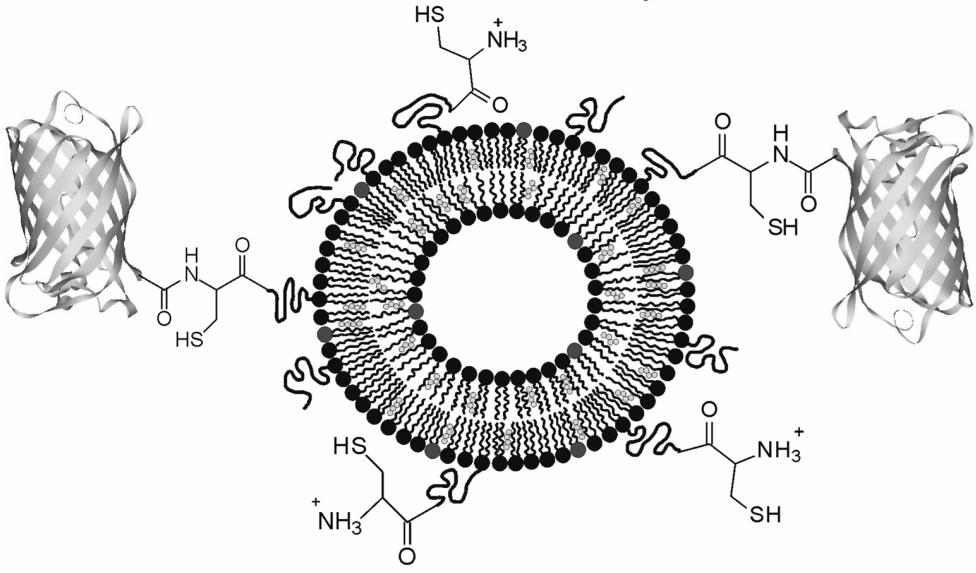Protein Liposome Conjugation
As a premium service provider in the field of drug development, BOC Sciences has extensive expertise in liposome conjugation. With the advanced coupling techniques and experienced team, we provide protein liposome conjugation service to improve drug delivery project.
What is Protein Liposome Conjugation
Protein liposome conjugates represent an ingenious synergy between two pivotal scientific domains: proteins, the building blocks of life, and liposomes, tiny lipid-based vesicles that can ferry payloads to specific targets within the body. This convergence has given rise to a plethora of opportunities in drug delivery, diagnostics, and even basic research.
At the heart of this innovation is the process of protein encapsulation in liposomes. This technique involves encapsulating proteins of interest within the lipid bilayer of liposomes, creating a protective cocoon that shields the protein from enzymatic degradation and other external factors. In addition, Protein liposome conjugation involves directly attaching proteins to the liposome's surface via covalent conjugation, allowing control over the orientation and density of attached proteins. The resulting protein-liposomes can be engineered to deliver their cargo with precision to targeted cells or tissues.
 Figure 1. Chemical ligation of liposomes with proteins. (Reulen, 2007)
Figure 1. Chemical ligation of liposomes with proteins. (Reulen, 2007)
Custom Protein Liposome Conjugates
BOC Sciences provides customized protein liposome conjugates, including liposome surface modification and protein liposome encapsulation, to meet your special needs.
- Trastuzumab-Enriched Liposomes
- Insulin-Loaded Liposomes
- Cytokine-Loaded Liposomes
- Antibody-Drug Conjugate Liposomes
- Enzyme Liposomes
Protein Encapsulation in Liposomes
Protein encapsulation within liposomes is a technique that addresses the challenges in drug delivery - ensuring the stability and efficacy of therapeutic proteins. Liposomes are composed of lipid bilayers that mimics cellular membranes, providing a natural-like environment for protein encapsulation. Proteins can be either encapsulated within the liposome's aqueous core, ideal for hydrophilic proteins, or embedded within the lipid bilayer, suitable for hydrophobic proteins. This dual capability makes liposomes versatile carriers for a wide range of protein types, ensuring that the protein's structure and function remain intact during delivery.
BOC Sciences's scientist team continually refines this process to ensure optimal protein loading while maintaining the structural integrity of the encapsulated protein. Advanced techniques such as microfluidics and thin-film hydration can be employed to precisely control liposome size and composition, allowing for better encapsulation efficiency and stability.
Liposome Protein Delivery
In recent years, various therapeutic applications of protein encapsulation in liposomes have gained traction. One prominent example is enzyme replacement therapy, where liposomes encapsulate deficient enzymes in disorders like lysosomal storage diseases. The liposome acts as a protective carrier, enabling the enzyme to reach its target site intact and exert its intended function. Another exciting avenue is the delivery of antibodies via liposomes. Antibodies are essential components of the immune system and have demonstrated therapeutic potential in treating cancer and autoimmune disorders. Liposomes offer a solution by encapsulating antibodies and delivering them for minimizing off-target effects.
Cryo-EM Analysis of Liposome-Embedded Proteins
Cryo-EM can be used to visualize macromolecules at near-atomic resolution. This technique involves freezing samples in a thin layer of vitreous ice, preserving their native state. By rapidly freezing the sample, potential artifacts and distortions caused by traditional sample preparation methods are minimized.
- cryo-EM can analyze proteins in their natural lipid environment within liposomes. This is particularly crucial for understanding the interactions between proteins and lipids, as well as how these interactions influence protein structure and function.
- Cryo-EM can visualize the spatial orientation of proteins within liposomes. When proteins are embedded in the lipid bilayer, cryo-EM images can reveal how proteins are integrated into the membrane.
- cryo-EM can capture proteins encapsulated within the aqueous core of liposomes. This provides information about the distribution and arrangement of proteins within the liposome interior.
Frequently Asked Questions (FAQ)
Proteins anchored to liposome surfaces can locally influence lipid packing and curvature, providing a controllable model to study nanoscale membrane remodeling and protein-induced structural changes.
Yes. Protein properties such as domain flexibility and surface charge can drive ordered arrangements or clustering on liposomes, enabling exploration of nanoscale pattern formation and self-assembly mechanisms.
Liposomes serve as nanoscale scaffolds, allowing observation of cooperative binding, steric effects, or multimerization of proteins in a confined environment that mimics membrane surfaces.
Conjugated proteins can segregate lipids into localized microdomains, revealing principles of membrane heterogeneity, surface crowding, and nanoscale organizational dynamics.


Reference
- Reulen, S. W. A., et al., Protein-Liposome Conjugates Using Cysteine-Lipids And Native Chemical Ligation, Bioconjugate Chem., 2007, 18, 2, 590-596.